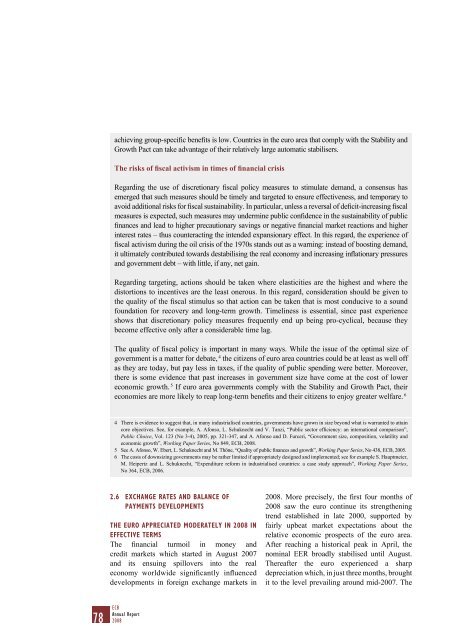ANNUAL REPORT 2008 - Polymer Bank Notes of the World
ANNUAL REPORT 2008 - Polymer Bank Notes of the World
ANNUAL REPORT 2008 - Polymer Bank Notes of the World
Create successful ePaper yourself
Turn your PDF publications into a flip-book with our unique Google optimized e-Paper software.
achieving group-specific benefits is low. Countries in <strong>the</strong> euro area that comply with <strong>the</strong> Stability andGrowth Pact can take advantage <strong>of</strong> <strong>the</strong>ir relatively large automatic stabilisers.The risks <strong>of</strong> fiscal activism in times <strong>of</strong> financial crisisRegarding <strong>the</strong> use <strong>of</strong> discretionary fiscal policy measures to stimulate demand, a consensus hasemerged that such measures should be timely and targeted to ensure effectiveness, and temporary toavoid additional risks for fiscal sustainability. In particular, unless a reversal <strong>of</strong> deficit-increasing fiscalmeasures is expected, such measures may undermine public confidence in <strong>the</strong> sustainability <strong>of</strong> publicfinances and lead to higher precautionary savings or negative financial market reactions and higherinterest rates – thus counteracting <strong>the</strong> intended expansionary effect. In this regard, <strong>the</strong> experience <strong>of</strong>fiscal activism during <strong>the</strong> oil crisis <strong>of</strong> <strong>the</strong> 1970s stands out as a warning: instead <strong>of</strong> boosting demand,it ultimately contributed towards destabilising <strong>the</strong> real economy and increasing inflationary pressuresand government debt – with little, if any, net gain.Regarding targeting, actions should be taken where elasticities are <strong>the</strong> highest and where <strong>the</strong>distortions to incentives are <strong>the</strong> least onerous. In this regard, consideration should be given to<strong>the</strong> quality <strong>of</strong> <strong>the</strong> fiscal stimulus so that action can be taken that is most conducive to a soundfoundation for recovery and long-term growth. Timeliness is essential, since past experienceshows that discretionary policy measures frequently end up being pro-cyclical, because <strong>the</strong>ybecome effective only after a considerable time lag.The quality <strong>of</strong> fiscal policy is important in many ways. While <strong>the</strong> issue <strong>of</strong> <strong>the</strong> optimal size <strong>of</strong>government is a matter for debate, 4 <strong>the</strong> citizens <strong>of</strong> euro area countries could be at least as well <strong>of</strong>fas <strong>the</strong>y are today, but pay less in taxes, if <strong>the</strong> quality <strong>of</strong> public spending were better. Moreover,<strong>the</strong>re is some evidence that past increases in government size have come at <strong>the</strong> cost <strong>of</strong> lowereconomic growth. 5 If euro area governments comply with <strong>the</strong> Stability and Growth Pact, <strong>the</strong>ireconomies are more likely to reap long-term benefits and <strong>the</strong>ir citizens to enjoy greater welfare. 64 There is evidence to suggest that, in many industrialised countries, governments have grown in size beyond what is warranted to attaincore objectives. See, for example, A. Afonso, L. Schuknecht and V. Tanzi, “Public sector efficiency: an international comparison”,Public Choice, Vol. 123 (No 3-4), 2005, pp. 321-347, and A. Afonso and D. Furceri, “Government size, composition, volatility andeconomic growth”, Working Paper Series, No 849, ECB, <strong>2008</strong>.5 See A. Afonso, W. Ebert, L. Schuknecht and M. Thöne, “Quality <strong>of</strong> public finances and growth”, Working Paper Series, No 438, ECB, 2005.6 The costs <strong>of</strong> downsizing governments may be ra<strong>the</strong>r limited if appropriately designed and implemented; see for example S. Hauptmeier,M. Heipertz and L. Schuknecht, “Expenditure reform in industrialised countries: a case study approach”, Working Paper Series,No 364, ECB, 2006.2.6 EXCHANGE RATES AND BALANCE OFPAYMENTS DEVELOPMENTSTHE EURO APPRECIATED MODERATELY IN <strong>2008</strong> INEFFECTIVE TERMSThe financial turmoil in money andcredit markets which started in August 2007and its ensuing spillovers into <strong>the</strong> realeconomy worldwide significantly influenceddevelopments in foreign exchange markets in<strong>2008</strong>. More precisely, <strong>the</strong> first four months <strong>of</strong><strong>2008</strong> saw <strong>the</strong> euro continue its streng<strong>the</strong>ningtrend established in late 2000, supported byfairly upbeat market expectations about <strong>the</strong>relative economic prospects <strong>of</strong> <strong>the</strong> euro area.After reaching a historical peak in April, <strong>the</strong>nominal EER broadly stabilised until August.Thereafter <strong>the</strong> euro experienced a sharpdepreciation which, in just three months, broughtit to <strong>the</strong> level prevailing around mid-2007. The78 ECBAnnual Report<strong>2008</strong>




![KNOW YOUR NEW GIBRALTAR BANKNOTES - [Home] bThe/b](https://img.yumpu.com/50890985/1/184x260/know-your-new-gibraltar-banknotes-home-bthe-b.jpg?quality=85)
![PAPUA NEW GUINEA - [Home] - Polymer Bank Notes of the World](https://img.yumpu.com/49758743/1/190x143/papua-new-guinea-home-polymer-bank-notes-of-the-world.jpg?quality=85)










